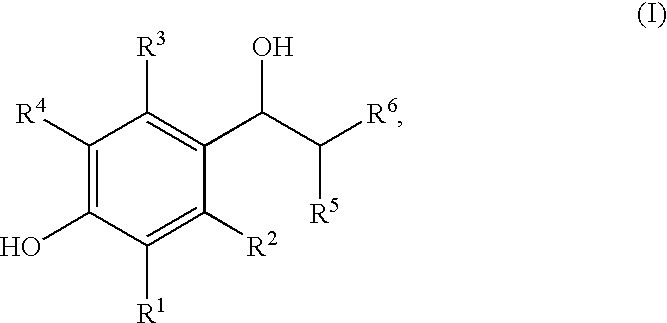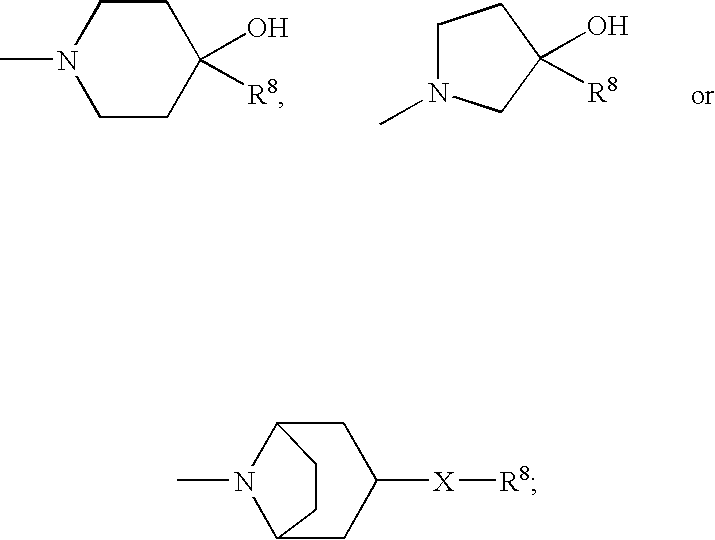NMDA NR2B antagonists for treatment
a technology of nmda and nr2b, which is applied in the field of neurological disorders, can solve problems such as preventing the advancement of this class of molecules in the clini
- Summary
- Abstract
- Description
- Claims
- Application Information
AI Technical Summary
Benefits of technology
Problems solved by technology
Method used
Image
Examples
example 1
Enantiomeric (1S,2S)- and (1R,2R)-1-(4-Hydroxy-phenyl)-2-(4-hydroxy-4-phenylpiperidin-1-yl)-1-propanol
[0090](+)-Tartaric acid (300 mg, 2 mmol) was dissolved in 30 mL warm methanol. Racemic 1S*,2S*-1-(4-hydroxyphenyl)-2-(4-hydroxy-4-phenylpiperidin-1-yl)-1-propanol (655 mg, 2 mmol) was added all at once. With stirring and gentle warming a colorless homogeneous solution was obtained. Upon standing at ambient temperature 24 hours, 319 mg (66%) of a fluffy white precipitate was obtained. This product was recrystallized from methanol to give 263 mg of the (+)-tartrate salt of levorotatory title product as a white solid; mp 206.5-207.5° C.; [alpha]D=−36.2°. This salt (115 mg) was added to 50 mL of saturated NaHCO3. Ethyl acetate (5 mL) was added and the mixture was vigorously stirred 30 minutes. The aqueous phase was repeatedly extracted with ethyl acetate. The organic layers were combined and washed with brine, dried over calcium sulfate, and concentrated. The tan residue was recrystalli...
example 2
(1S,2S)-1-(4-hydroxyphenyl)-2-(4-hydroxy-4-phenylpiperidin-yl)-1-propanol methanesulfonate trihydrate
[0092]Step 1
[0093]A 50 gallon glass lined reactor was charged with 17.1 gallons of acetone, 8.65 kilograms (kg) (57.7 mol) of 4′-hydroxypropiophenone, 9.95 kg (72.0 mol) of potassium carbonate and 6.8 liters (l) (57.7 mol) of benzylbromide. The mixture was heated to reflux (56° C.) for 20 hours. Analysis of thin layer chromatography (TLC) revealed that the reaction was essentially complete. The suspension was atmospherically concentrated to a volume of 10 gallons and 17.1 gallons of water were charged. The suspension was granulated at 25° C. for 1 hour. The product was filtered on a 30″ Lapp and washed with 4.6 gallons of water followed by a mixture of 6.9 gallons of hexane and 2.3 gallons of isopropanol. After vacuum drying at 45° C., this yielded 13.35 kg (96.4%) of the above-depicted product.
[0094]A second run was carried out with 9.8 kg (65.25 mol) of 4′-hydroxypropiophenone usi...
example 3
(1R*,2R*)-1-(4-hydroxy-3-methylphenyl)-2-(4-(4-fluorophenyl)-4-hydroxypiperidin-1-yl)-propan-1-ol-mesylate
[0105]A mixture of 3-methyl-4-triisopropylsilyloxy-α-bromopropiophenone (9.17 g, 22.97 mmol), 4-(4-fluorophenyl)-4-hydroxypiperidine (6.73g, 34.45 mmol) and triethylamine (8.0 mL, 57.43 mmol) in in ethanol (180 mL) was refluxed for 6 hours. The solvent was removed at reduced pressure and the residue was partitioned between ethyl acetate and water. The phases were separated and the organic layer was washed with brine, dried over calcium sulfate and concentrated. The residue was flash chromatographed on silica gel (3×3.5 inches packed in hexane) with elution proceeding as follows: 10% ethyl acetate / hexane (1000 mL), nil; 20% ethyl acetate / hexane (700 mL), nil; 20% ethyl acetate / hexane (1300 mL) and 25% ethyl acetate / hexane (600 mL), 7.66 g (65%) of 1-(3-methyl-4-triisopropylsilyloxyphenyl)-2-(4-(4-fluorophenyl)-4-hydroxypiperidin-1-yl)-propan-1-one as a yellow foam which was suita...
PUM
| Property | Measurement | Unit |
|---|---|---|
| optical purity | aaaaa | aaaaa |
| optical purity | aaaaa | aaaaa |
| optical purity | aaaaa | aaaaa |
Abstract
Description
Claims
Application Information
 Login to View More
Login to View More - R&D
- Intellectual Property
- Life Sciences
- Materials
- Tech Scout
- Unparalleled Data Quality
- Higher Quality Content
- 60% Fewer Hallucinations
Browse by: Latest US Patents, China's latest patents, Technical Efficacy Thesaurus, Application Domain, Technology Topic, Popular Technical Reports.
© 2025 PatSnap. All rights reserved.Legal|Privacy policy|Modern Slavery Act Transparency Statement|Sitemap|About US| Contact US: help@patsnap.com



